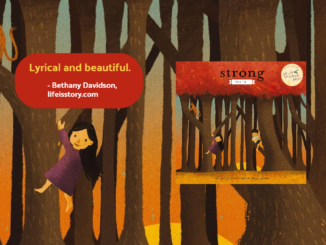
Also by this author: The Sower
Published by Rabbit Room Press on May 31, 2020
Genres: Fiction, Christian, Fantasy
Buy on Amazon
Goodreads

"They believed they had come to the last turning of the wheel."
When the Bloodmoon rose, death came rushing into the world. Now the water is bitter, blight consumes everything, and the Crone haunts the hills.
While the Druid of Blackthorn searches desperately for hope, the Ovate returns from the underworld bringing omens of despair. But Idris, the young bard, Keeper of the Sacred Word, will walk through fire and iron to uncover a question no one has ever dared to ask--a question that carries a world of answers on its back, a question that can change everything.
But his time is short. The land is dying. And the Bloodmoon is rising again.
What this book lacks in plot, it makes up for many times over in atmosphere. The only criticism I have of The Door on Half-Bald Hill is that the story—a fairly standard journey narrative—is overshadowed by the Celtic mythos into which Sorensen entices her readers. There is an aura of mystery that hangs over the story. If you are versed in Celtic lore, you may follow it a bit easier or know the way a bit better. But in this, the wandering and wondering is part of the experience.
Every bit of The Door on Half-Bald Hill exudes artistry. It begins with Sorensen’s literary tone and weighty symbolism, but extends through to the book’s design and structure. Everything from the illustrations of the moon’s cycle at every chapter heading to the deckled edges of the pages to the haunting woodcut-esque cover shows that great care was taken to present this book as a work of art. Not just the story, but the book itself.
As for the story, The Door on Half-Bald Hill is about eschatological apocalypse. The world is dying. The people are hurting. The water is bitter. The field is blighted. The Crone haunts the hills. The Ovate has returned from the underworld with omens of despair. Yet, there is a search for hope. Idris, a young bard, will journey through fire and iron in an attempt to save his people. It will be a journey fraught with peril. If all of that sounds vague and mysterious, then you’ve begun to understand the book. I don’t want to share too much because the mystery is large part of it. This is a book that is felt as much as it’s read. Sorensen’s evocativeness covers over a rather sparse narrative.
This is a dark and bleak story, but its story written for the message, written for the twist. It’s not an unforeseen twist by any means, but there is a reason Sorensen drags you through the darkness. It is a redemption story par excellence. Sorensen’s use of Celtic imagery is novel to redemptive allegory, at least my experience with it. The tone of the story fits Celtic and legend and Sorensen’s depiction isn’t a Christianization of the stories but embraces them as they are to show that redemption—and the story of redemption—can come through unexpected means.
The Door on Half-Bald Hill isn’t a book to read a review about, because a review cannot do it justice. It requires a certain mood. It requires a certain taste in literature. For those whom this book is for, it is a masterpiece. But it isn’t a book for everyone. It’s not an easy read. It’s not a typical read. While I wish the characterization had been a bit stronger and the narrative a bit clearer, the novel’s atmosphere forced me to slow down and consider every morsel, test every mystery. I do wish I had known more Celtic legend going into the book and that’s maybe another area Sorensen could have improved upon. This is a book that’s easy to get lost in and give up, but it’s also easy to get lost within and become immersed in the world Sorensen brings to life. The Door on Half-Bald Hill is a true work of art.



